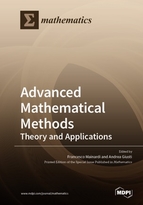Advanced Mathematical Methods: Theory and Applications
A special issue of Mathematics (ISSN 2227-7390).
Deadline for manuscript submissions: closed (15 October 2019) | Viewed by 43748
Special Issue Editors
Interests: special functions; fractional calculus complex analysis; asymptotic methods; diffusion and wave propagation problems
Special Issues, Collections and Topics in MDPI journals
Interests: fractional calculus; special functions; viscoelasticity; theoretical and mathematical physics
Special Issue Information
Dear Colleagues,
The many technical and computational problems that appear to be constantly emerging in various branches of physics and engineering beg for a more detailed understanding of the fundamental mathematics that serves as the cornerstone of our way of understanding natural phenomena. The purpose of this Special Issue is to establish a collection of a restricted number of carefully selected articles authored by promising young scientists and the world’s leading experts in pure and applied mathematics, highlighting the state-of-the-art of the various research lines focussing on the study of analytical and numerical mathematical methods for pure and applied sciences.
We are also interested in methods including non-local operators related to fractional calculus, even though this is not necessarily the main theme of the Special Issue. It is additionally worth stressing that papers involving applications to deterministic and stochastic phenomena are welcome.
Prof. Francesco Mainardi
Dr. Andrea Giusti
Guest Editors
Manuscript Submission Information
Manuscripts should be submitted online at www.mdpi.com by registering and logging in to this website. Once you are registered, click here to go to the submission form. Manuscripts can be submitted until the deadline. All submissions that pass pre-check are peer-reviewed. Accepted papers will be published continuously in the journal (as soon as accepted) and will be listed together on the special issue website. Research articles, review articles as well as short communications are invited. For planned papers, a title and short abstract (about 100 words) can be sent to the Editorial Office for announcement on this website.
Submitted manuscripts should not have been published previously, nor be under consideration for publication elsewhere (except conference proceedings papers). All manuscripts are thoroughly refereed through a single-blind peer-review process. A guide for authors and other relevant information for submission of manuscripts is available on the Instructions for Authors page. Mathematics is an international peer-reviewed open access semimonthly journal published by MDPI.
Please visit the Instructions for Authors page before submitting a manuscript. The Article Processing Charge (APC) for publication in this open access journal is 2600 CHF (Swiss Francs). Submitted papers should be well formatted and use good English. Authors may use MDPI's English editing service prior to publication or during author revisions.
Keywords
- applied mathematics
- mathematical modelling
- mathematical physics
- mathematical methods for applied and theoretical sciences
- numerical methods
- special functions
- integral transforms
- non-local operators






